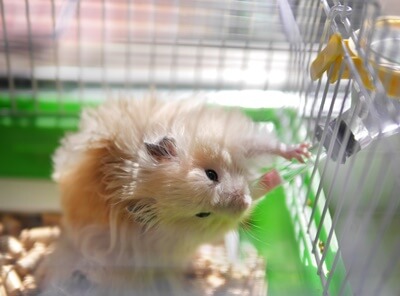While hamsters are descended from ancestors from arid desert conditions, those who enter homes are born and raised in pet stores. So, hamsters are used to having access to fresh drinking water.
The signs of dehydration in hamsters are loose, saggy skin and sunken eyes.
Pinch the skin around the neck. If the body lacks water, the skin remains tented and doesn’t snap back into place. Other warning signs include panting and struggling for air, failing to urinate, and lethargy.
Treat dehydration by filling a bottle with clean water and an electrolyte solution. If the hamster refuses water through its bottle, use a small syringe, slowly releasing the fluid in short, controlled doses.
After administering first aid to a dehydrated hamster, a vet may provide fluids intravenously.
Why Do Hamsters Get Dehydrated?
Here are the ways hamsters become dehydrated:
| Distaste for water | The water in a hamster’s bottle may have grown stagnant. Alternatively, there are alternatives to water if a hamster won’t drink. |
| Broken bottle | If a water bottle is damaged somehow, the water will drain away, and the hamster won’t be able to drink. Check the bottle regularly for signs of wear and tear. |
| Excessive heat | If a hamster’s home is too warm, it’ll grow dehydrated, no matter how much it drinks. The ideal ambient temperature for hamsters is 65-75OF. |
| Insufficient vegetables | Fresh vegetables are a means of hydration and electrolytes (sodium, potassium, chloride, calcium, and magnesium), so provide carrots, celery, and cucumber. |
| Excessive exercise | As hamsters exercise, they lose water through sweat and respiration. It’s normal for hamsters to run for miles on their wheels, but some become addicted to running. |
| Inability to access water | Ensure the hamster can easily reach its water bottle and that nothing is blocking the water flow. If the water bottle is elevated in a cage, an older, arthritic hamster or an animal with an injury like a broken leg may be unable to access it. |
| Overgrown teeth | Ensure the hamster is gnawing and wearing down its teeth regularly. If the upper and lower incisors grow too long, the hamster will be in pain when it tries to eat or drink. |
| Urinary tract infections | Hamsters may avoid drinking if they have a urinary tract infection (UTI). This condition will make it painful for a hamster to pee, meaning it won’t drink. |
| Vomiting or diarrhea | If a hamster is unwell, it’ll lose water at a rate that’s difficult to replace. Take loose stools very seriously, as this could signify wet tail. |
| Diabetes | According to the journal Diabetes, hamsters – especially Chinese hamsters – can be prone to diabetes. A diabetic hamster will constantly be thirsty and dehydrated, no matter how much it drinks. |
If you ask, “Why is my hamster not drinking water?” – or, even more concerning, your hamster is drinking normally but remains dehydrated – a vet must determine why.
How Long Can Hamsters Survive Without Water?
As hamsters descend from desert-dwelling animals, you would be forgiven for assuming it can last for days without drinking water. This, unfortunately, isn’t the case.
If you wonder, “Can hamsters die from dehydration?” the answer is an unqualified yes. Like all living things, hamsters rely on water to keep their organs flourishing and working fully. A hamster could pass away within 3-4 days if left to dehydrate.
The consequences of dehydration can take hold long before this and leave the hamster’s health in peril. Dehydration may lead to other concerns, which are more pronounced hazards, including heart problems.
An old or young hamster is most at risk if it fails to hydrate for 24 hours.
How Do I Know if My Hamster is Drinking Enough Water?
The average hamster must drink 10-30 ml of water daily. When you fill a hamster’s water bottle, use a Sharpie to note the water level.
When you check later, assuming the hamster is awake and active, there should be daylight between this mark and the top of the water level.
If nothing has moved, this suggests the hamster isn’t drinking.

How Do You Know if a Hamster is Dehydrated?
Given the potential dangers of dehydration in small animals, you must recognize common hamster dehydration symptoms and take action.
Here are the warning signs of what happens if a hamster is dehydrated:
Panting
As per Veterinary Clinics of North America: Exotic Animal Practice, hamsters are obligate nasal breathers. Something is amiss whenever a hamster breathes through the mouth, especially if labored.
Panting and struggling for breath could be a sign of respiratory infection or even a heart problem. This behavior is also associated with dehydration, as the body works hard to cope with the lack of water, placing pressure on its vital organs.
Check for other signs of sickness, including streaming from the nose or eyes that suggest it has a cold, and move the cage to a cooler location if the ambient temperature is above 75° F.
Loose, Sagging Skin
Hamsters’ skin should be elastic and tight; if it is loose and saggy, it’s likely dehydrated.
Gently pinch the fur around the scruff of the hamster’s neck. Be careful not to hurt the hamster, or it’ll bite in defense. The hamster’s water intake is normal if the skin snaps back into place immediately.
If the skin takes a while to return to its usual position, remaining tented, the hamster needs to rehydrate.
Droopy, Sunken Eyes
Happy, healthy hamsters have bright and shiny eyes, while the eyes of a dehydrated hamster will sink deeper into the skull, displaying none of their usual luster, and may droop.
Check that the hamster doesn’t have another eye problem, such as sticky eye.

Dark Urine or Failing to Urinate
When a hamster drinks water, it’ll eventually need to pass this water as urine. A typical hamster will pee up to 7 times per day.
If the hamster isn’t urinating, it stands to reason that it’s not drinking enough or any fluid taken into its body isn’t having the desired effect.
Look at any urine that the hamster does pass. If it is thick, sludgy, or colored orange or brown, this suggests a concern with the hamster’s hydration levels.
Lethargy and Inactivity
A lack of water may be to blame if a hamster spends more time sleeping when it usually runs on its exercise wheel or interacts with cagemates.
Weight Loss And Unkempt Appearance
As dehydration leaves a hamster tired and lethargic, it’ll also lose interest in grooming. The hamster will also lose appetite while losing water weight, making it look noticeably thinner.
Cracked and dry noses signify dehydration in hamsters, as the nose should be moist and supple. If the skin on the nose is dry and cracked, it’s likely the hamster isn’t drinking sufficient water.
Constipation
If a hamster ceases to pass droppings as often or their stools are harder than usual, it could signify dehydration.
A severely dehydrated hamster may no longer be able to move waste through its digestive tract, so it stops pooping entirely.
Loss of Coordination
Signs of loss of coordination include difficulty moving, standing, balancing, and walking in a straight line.
What to Do if Your Hamster is Dehydrated
If the hamster uses its bottle, add some electrolytes to the water. The over-the-counter remedy Pedialyte is found in most drug stores and supermarkets and will help the hamster rehydrate.
Alternatively, add a pinch of salt and sugar to the hamster’s water. This will replenish electrolytes, but a pre-prepared solution will be more balanced and beneficial.
A vet will assess the hamster and confirm if it needs an intravenous drip of fluids, which will be administered subcutaneously.





